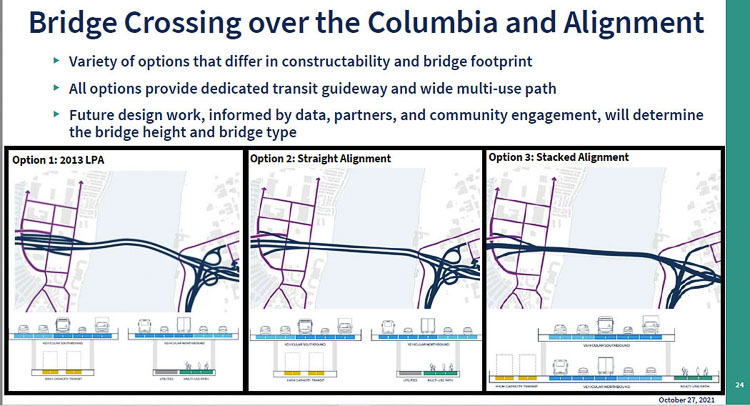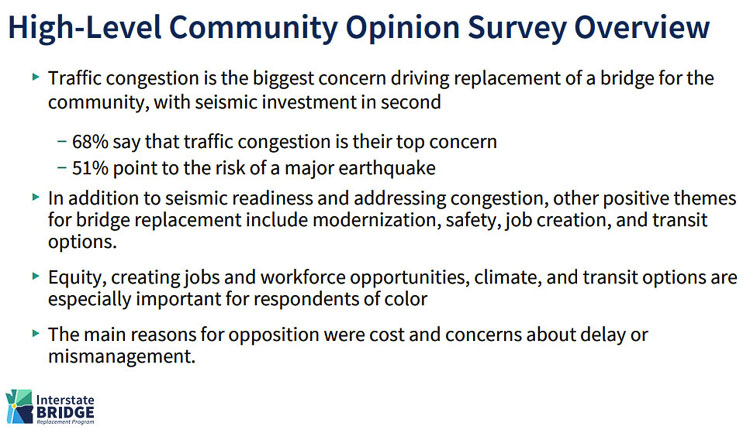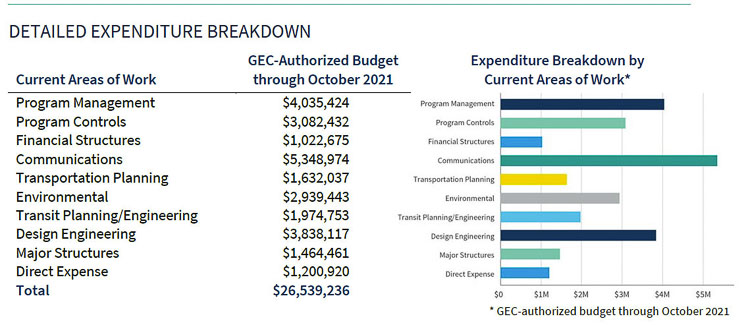Five of 10 transit options include light rail, as bridge design options revealed to legislators
The 16-member Bi-state Bridge Committee of Oregon and Washington legislators met on Wednesday to receive an update on the Interstate Bridge Replacement Program (IBR). Last week the Executive Steering Group (ESG), received a similar briefing. The IBR team continues to move forward towards producing one final “solution” by next March.
The two-year effort has spent nearly $21 million through the end of August. One quarter of that ($5.3 million) has been spent on “communication,” as dozens of community outreach sessions have been held. The Community Advisory Group (CAG) and Equity Advisory Group (EAG) have sought to provide residents on both sides of the river the opportunity to make input.
WSP USA has received 45 percent of the money, as the primary consultant for the IBR team. Parametrix, Inc. has received 30 percent of the funds, as the second largest consultant.
In November, the IBR team expects to share some initial traffic data with the legislators and the community. This will be taken from de-identified cell phone data as well as data taken from trucks and freight haulers. Citizens have been asking for this type of data ever since the program was restarted.
The options
The legislators were presented with three primary options for the replacement bridge structure. Two of those options included two separate bridges, side-by-side, similar to the current Interstate Bridge structures. One option was a single large bridge. All three options are two-level bridge structures. Two have main freeway traffic on the top level and transit, bike and pedestrian traffic on the lower level. The “stacked option” of a single, wider bridge has freeway traffic on both levels.

One of those options was the 2013 Locally Preferred Alternative (LPA) from the failed Columbia River Crossing (CRC). That bridge design had a curve to the west in the middle of the bridge and river. The team offers this primarily as a comparison piece for consideration.
The final evaluation will also offer a “no-build option” presented to the federal government. This is part of a required part of a revised, Supplemental Environmental Impact Statement (SEIS) required to obtain federal funding.
Option number two is described as the straight alignment option. It removes the curve as much as possible while maintaining the two bridge/two-level highway over the transit/multi-use path configuration. Technical considerations include the straight alignment is west of the Interstate 5 (I-5) corridor on Hayden Island. This alignment makes the likely North Portland Harbor bridge replacement less complex. A straight alignment is less complex to construct than a curving structure.
The third option is a single bridge, stacked structure. The stacked alignment option consolidates all elements into one bridge, with southbound highway lanes on top of northbound highway lanes. Transit and the multi-use path would be on the lower level on each side of the bridge.
Technical considerations include a smaller footprint over the river and reduce the number of foundations in the water compared to the other options, thus minimizing impacts to the natural environment and surrounding areas.
According to Greg Johnson, IBR Program Administrator, his team is seeking to answer four primary questions. How many auxiliary lanes to include in the project, in addition to the three planned through lanes? Do they replace or do a seismic upgrade to the north Portland Harbor bridge connecting Hayden Island to mainland Portland? Do they include any I-5 interchanges on Hayden Island, or make connections via the Marine Drive interchange? What type of high capacity transit is proposed?
The various design options pertain to the following program areas:
- Hayden Island and Marine Drive interchanges including the North Portland Harbor bridge
- Bridge Crossing over the Columbia and Alignment
- Downtown Vancouver
- Vancouver Interchanges
- Transit
- Active transportation improvements
During questioning by legislators, it was revealed that the cost of replacing the north Portland Harbor bridge is $200 million more than a seismic upgrade. While an upgrade is still an option, comments by the IBR team indicate they lean heavily towards a replacement.
Johnson shared that last week the Executive Steering Group (ESG) providing oversight of the project had given their approval to move forward with these three options. However several members expressed concerns about the timeline moving too fast, and not having enough data and details. Not having enough data and details has become a common theme among legislators on the 16-member Bi-state Bridge Committee.
“They believe that we are moving too fast that we may not be able to fully answer all of their questions before we’re asking them to approve us moving on with the IBR solution,” Johnson said.
Portland’s Jo Ann Hardesty shared her concern at last week’s ESG meeting that the project is moving toward a predetermined outcome, reported BikePortland. “My concern is that the design options for the bridge alignment and interchanges have been developed in a way that suggests that we already know what the solution is.” Many citizens have suggested this is a resurrection of the failed Columbia River Crossing, since ideas like the Common Sense Alternative or a tube tunnel have been swept aside.
The “limit people’s use of cars” and climate change concerns were at the top of the pushback at the ESG. Both Hardesty and Metro’s Lynn Peterson gave voice to these issues.
The final solution “needs to demonstrate how it won’t contribute to more 124 degree days like we experienced just this last summer in the Lents neighborhood in Portland,” Hardesty said. “It needs to demonstrate how it won’t contribute to elevated rates of asthma and hospitalization for black and brown Portlanders, which normally are the recipients of the negative outcomes of freeway activity,” she told the group. “Are we really moving the project forward in a way where we can be confident that, in the design options we will explore, that we are addressing these very core issues?”
Metro President Lynn Peterson was the other voice in the room pushing back, explicitly asking for an additional highway design option to act as a “bookend.” She suggested that option should look at “what would it look like if there was a more robust transit, a more robust congestion pricing program, what does that do to demand, so that we can actually see how that works and what elements are playing with what?”
Peterson said the assumptions on how pricing may impact demand for the highway seem “too muted” at this point. But those studies are being done by ODOT in their Rose Quarter project and in their two tolling programs, so it would seem any lack of data on tolling impacts is a burden for officials on the Oregon side.
Johnson mentioned that his team has put together several community working groups in September and October that are soliciting feedback on the four major decision points, including transit options, the “commuting experience,” input from Hayden Island residents, and Vancouver options.
Sen. Ann Rivers (Republican, 18th District) asked if the team was taking into consideration changes in public transit use. She noted C-TRAN’s new Bus Rapid Transit (BRT) is part of what has changed. The IBR team’s multiple transit options include several BRT options, some Bus on Shoulder (BOS) options, and half included TriMet’s light rail transit (LRT) options.
Chris Regan responded with “we should really focus on what are the desired outcomes? What are our program priorities?” They hope to get more people to use transit.
“With public transportation, we’re trying to ensure our desired outcome is that when people use the transit, it’s competitive with other modes, it connects people to their origins and destinations,” Regan said. They want to ensure “it’s predictable, reliable, consistent, and that more people have access to high quality, affordable and reliable transit.”
Sen. Lynda Wilson (Republican, 17th District) noted the “transit is competitive with other modes” statement, and asked how the team is measuring that?
The team shared 14 “evaluation measures” for the numerous high capacity transit (HCT) options. The preliminary transit options include various representative HCT alignments that expand transit service. These options extend both bus rapid transit and/or light rail from their current area of service to stations on Hayden Island and Vancouver. This list also includes an option with Express Bus service.

Regan said they have a lot of data and modeling that they have to do before making their final recommendation. He showed a “no build” option and nine other options in the transit package. They include one Bus on Shoulder option, three BRT options, four light rail options, and one combined BRT/LRT option.
The expansion of HCT is called for in the Purpose and Need statement, in spite of the decline in transit ridership the metro area has experienced over the past decade or two. C-TRAN recently proposed permanent cuts to their service, especially their service across the Columbia River. The decline has been experienced all around the Pacific Northwest as people return to their cars but avoid public transportation.
There was discussion about travel times for both vehicles and freight. Rep. Brandon Vick (Republican, 18th District) wanted to ensure freight issues were addressed. Other members voiced concerns about the ports and freight haulers’ needs being included in the solution.
“In looking at two of these outcomes, travel times through the program area are faster, more predictable, and freight times through the program area faster. Tell me how you work through that, with the prospects of growth, both in population and economic activity to be able to preserve that objective,” asked Rep. Jake Fey (Democrat, 27th District).
Johnson said they want to create a better operating segment of this freeway. “We know that one of the things that bogs down freight movements as well as other vehicular movements are the number of interchanges and how they interact with through traffic. So the concept of auxiliary lanes to keep that traffic separated, until they get up to speed to join in three through lanes, is one of the strategies.”
Fey followed up, mentioning that the government doesn’t restrict land use and growth. “The challenge is to make this bridge achieve the objectives over a long period of time,” he said.
Johnson responded that his team is looking to both Metro and the Southwest Washington Regional Transportation Council (RTC) for their growth models and plans.
Rep. Sharon Wylie (Democrat, 49th District) sought clarification on data and modeling. “I’m assuming that the complex modeling tools that we use in this process will be able to show the projection of traffic and the decrease speeds, if we don’t improve the entrances and exits.” She wants to be able to show “the people” the improvements the project will have on traffic.
All the community surveys the IBR team has conducted revealed that overwhelmingly the people want traffic congestion relief as their top priority for the project.
The Hayden Island community was presented three major options for the Interstate Bridge at a community session earlier this month. This highlights the issues facing the project, including four interchanges within a 2 mile area, and the 3 major options being considered. Video by Andi Schwartz
At their last meeting, Oregon Sen. Lew Frederick asked: “How much time will drivers save rather than just saying congestion will be addressed?” He referenced citizens’ dissatisfaction with the one minute improvement in the failed CRC effort. Johnson had responded that “we can’t build our way out of traffic congestion.”
This time Johnson responded “the modeling that we do, we’ll be able to project future conditions, future traffic loading, as well as predict how many crashes you would see in a corridor, how many incidents and things of that nature.”
Vick shared concerns for citizen input. “It feels like some of these advisory committees in their discussions have been kept in this sort of box.” He wants more information about citizens’ concerns.
McLain echoed Vick, expressing a concern about moving too fast. She fears people won’t buy into the final solution, and they need more specificity.
At last week’s ESG meeting, Lynn Valenter, a co-chair of the Community Advisory Group, abstained from giving a yes or a no on the proposed design “universe” because the CAG hadn’t even had the material presented to them yet. Those groups are a big part of the strategy in avoiding the outcome of 10 years ago, but will their input meaningfully change the outcome?
Wilson and Rivers sought clarification on tolling. “It says identify equitable tolling and pricing strategy supporting multimodal construction, does that mean that we’re going to be tolling for multimodal?” she asked. No, the tolling was just a means of funding all the other elements, including transit, bike and pedestrian improvements. None of the “active transportation” will be tolled.
Johnson reminded the legislators that his office does not have any control over the tolling. It will be each state legislature as well as the two state transportation commissions who will set the policy and the rates.
Susan McLain (Democrat, OR 29th District) mentioned the fact that there were two very different attitudes about transportation including transit, on each side of the Columbia River.
She also expresses concerns about being fiscally responsible, and wanted to ensure there would be multiple opportunities for legislators to hit the pause button or deal with cost issues. “There’s not just one opportunity to give guidance to say, greenlight go forward, red light, let’s stop and talk about this issue,” McLain said.

Fey echoed McLain’s concerns. “I think we do have fiscal responsibility here. We have to take the other kinds of desired outcomes in the context of fiscal responsibility. Because there will always be a limit as to how much resources can be put towards this project. That is a caveat for me.”
“They’re all good outcomes, but they can run at one against another, potentially, especially from a financial standpoint, and cost effectiveness standpoint,” he said.
From a financial perspective, the legislators were shown a slide indicating Oregon has committed $45 million to the project and Washington $35 million. It was noted that there is also $97.7 million Washington has set aside from the 2015 gas tax increase package that is available for the project beginning in August 2023.
It was shown that $26.5 million of expenditures has been authorized through Oct 2021.
The November meeting of the legislators will feature more details on traffic modeling data. In December the IBR Program team will present information on various governance structures. At some point they will provide an economic impact study showing money spent in the region, etc.






















